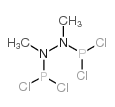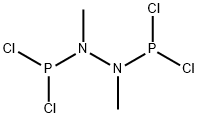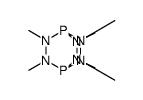1,2-双(二氯膦)-1,2-二甲基肼 ,1,2-Bis(dichlorophosphino)-1,2-dimethylhydrazine ,≥99%
产品编号:Bellancom-B406566| CAS NO:37170-64-2| 分子式:C2H6Cl4N2P2| 分子量:261.84200
本网站销售的所有产品仅用于工业应用或者科学研究等非医疗目的,不可用于人类或动物的临床诊断或者治疗,非药用,非食用,
| 英文名称 | 1,2-Bis(dichlorophosphino)-1,2-dimethylhydrazine |
|---|---|
| CAS编号 | 37170-64-2 |
| 精确质量 | 259.87600 |
| PSA | 33.66000 |
| LogP | 4.17400 |
| 稳定性 | 遵照规定使用和储存则不会分解。 |
| 储存条件 | 密闭于阴凉干燥环境中 |
相关文档
化学品安全说明书(MSDS)
下载MSDS质检证书(COA)
相关产品
| 风险声明 (欧洲) | 20/21/22-36/37/38 |
|---|---|
| 安全声明 (欧洲) | 26-36/37/39 |
| 海关编码 | 2928000090 |
|
Section 1: Product Identification Chemical Name:1,2-Bis(dichlorophosphino)-1,2-dimethylhydrazine, min. 98% CAS Registry Number:37170-64-2 Formula:Cl2PN(CH3)N(CH3)PCl2 EINECS Number:none Chemical Family:organophosphorus compound Synonym:None
Section 2: Composition and Information on Ingredients IngredientCAS NumberPercentACGIH (TWA)OSHA (PEL) Title Compound37170-64-2100%no datano data Section 3: Hazards Identification Harmful by inhalation and if swallowed. Inhalation of vapors may lead to headache and dizziness. Corrosive to Emergency Overview: skin, eyes and mucous membranes. Primary Routes of Exposure:Ingestion, skin, inhalation Eye Contact:Causes burns to the eyes. Skin Contact:Causes burns to the skin. The material has a pungent odor. Inhalation may lead to headaches and dizziness. Corrosive to nose and Inhalation: mucous membranes. Ingestion:Harmful if swallowed. Acute Health Affects:Harmful by inhalation and if swallowed. Corrosive to skin, eyes and respiratory tract. Chronic Health Affects:No information available on long-term chronic effects. NTP:No IARC:No OSHA:No SECTION 4: First Aid Measures Immediately flush the eyes with copious amounts of water for at least 10-15 minutes. A victim may need Eye Exposure: assistance in keeping their eye lids open. Get immediate medical attention. Wash the affected area with water. Remove contaminated clothes if necessary. Seek medical assistance if Skin Exposure: irritation persists. Remove the victim to fresh air. Closely monitor the victim for signs of respiratory problems, such as difficulty Inhalation: in breathing, coughing, wheezing, or pain. In such cases seek immediate medical assistance. Seek medical attention immediately. Keep the victim calm. Give the victim water (only if conscious). Induce Ingestion: vomiting only if directed by medical personnel. SECTION 5: Fire Fighting Measures Flash Point:no data Autoignition Temperature:no data Explosion Limits:no data Extinguishing Medium:carbon dioxide, dry powder or foam If involved in a fire, fire fighters should be equipped with a NIOSH approved positive pressure self-contained Special Fire Fighting Procedures: breathing apparatus and full protective clothing. Hazardous Combustion andIf involved in a fire this material may emit toxic organic fumes and vapors of phosphorus pentoxide. Decomposion Products: Unusual Fire or Explosion Hazards: No unusual fire or explosion hazards. SECTION 6: Accidental Release Measures Small spills can be mixed with vermiculite or other suitable absorbents. Spillage in areas not adequately Spill and Leak Procedures:ventilation will require an evacuation of site. Emergency response teams will require self-contained breathing apparatus. Spill should be absorbed into vermiculite or other suitable absorbent. SECTION 7: Handling and Storage Handling and Storage:Material must be handled and stored under an inert atmosphere of nitrogen or argon. SECTION 8: Exposure Controls and Personal Protection Eye Protection:Always wear approved safety glasses when handling a chemical substance in the laboratory. Skin Protection:Wear protective gloves and clothing. Ventilation:Material has a pungent odor. Always handle material in an efficient fume hood. If ventilation is not available a respirator should be worn. The use of respirators requires a Respirator Respirator: Protection Program to be in compliance with 29 CFR 1910.134. Ventilation:Material has a pungent odor. Always handle material in an efficient fume hood. Additional Protection:No additional protection required. SECTION 9: Physical and Chemical Properties Color and Form:colorless to slightly cloudy liq. Molecular Weight:261.84 Melting Point:no data Boiling Point:no data Vapor Pressure:no data Specific Gravity:no data Odor:acidic odor Solubility in Water:reacts with water SECTION 10: Stability and Reactivity Stability:air and moisture-sensitive liquid Hazardous Polymerization:no hazardous polymerization Conditions to Avoid:contact with air and moisture Incompatibility:water, oxidizing agents and halogens carbon dioxide, carbon monoxide, phosphorus pentoxide, nitrogen oxides, hydrogen chloride, and organic Decomposition Products: fumes. SECTION 11: Toxicological Information RTECS Data:No information available in the RTECS files. Carcinogenic Effects:No data available Mutagenic Effects:No data available Tetratogenic Effects:No data available SECTION 12: Ecological Information Ecological Information:No information available SECTION 13: Disposal Considerations Disposal:Dispose of according to local, state and federal regulations. SECTION 14: Transportation Shipping Name (CFR):Corrosive liquids, N.O.S. Hazard Class (CFR):8 Additional Hazard Class (CFR):NA Packaging Group (CFR):II UN ID Number (CFR):UN# 1760 Shipping Name (IATA):Corrosive liquid, N.O.S. Hazard Class (IATA):8 Additional Hazard Class (IATA):NA Packaging Group (IATA):II UN ID Number (IATA):UN# 1760 SECTION 15: Regulatory Information TSCA:Not listed in the TSCA inventory. SARA (Title 313):Title compound not listed. Second Ingredient:none SECTION 16 - ADDITIONAL INFORMATION N/A |
|
~% 
37170-64-2 |
| 文献:Noeth,H.; Ullmann,R. Chemische Berichte, 1974 , vol. 107, p. 1019 - 1027 |
|
~% 
37170-64-2 |
| 文献:Kriel, Frederik H.; Coates, Judy South African Journal of Chemistry, 2012 , vol. 65, p. 271 - 279 |









 浙公网安备 33010802013016号
浙公网安备 33010802013016号